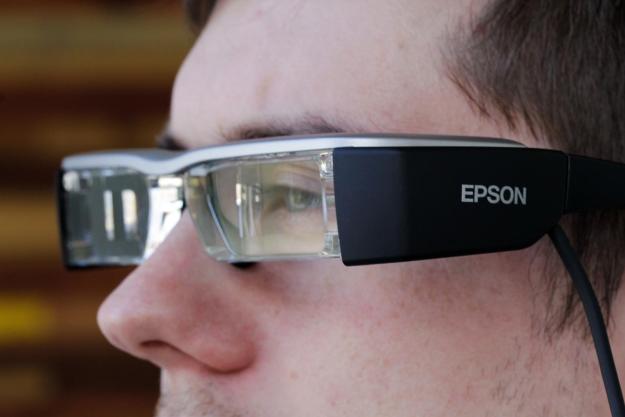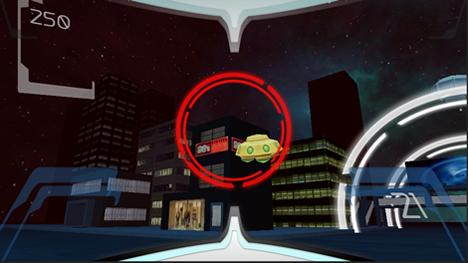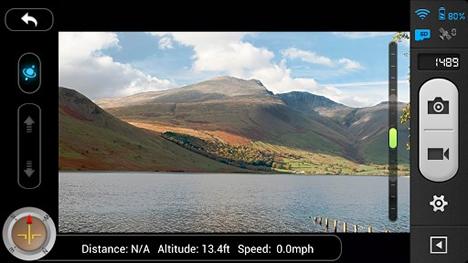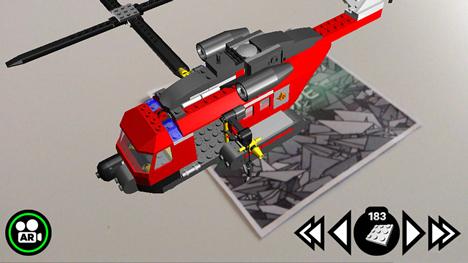
“Epson’s Android-based augmented reality platform has lots of potential. But the hardware could use an overhaul, and aside from Netflix and a few niche uses, it will hold limited appeal without ample app development.”
- Familiar Android interface
- Decent battery life
- Affordable
- Clunky hardware needs a lot of polish
- Low-end components
- Thick lenses often slipped down my nose
- Few substantive apps
Virtual reality has gobbled up headlines, thanks to the Oculus Rift and Samsung Gear VR. But with bulky headsets and software that’s still fairly limited, VR thus far has isolated users from reality (and social media) in a way that’s hard to square with today’s hyper-connected world.
Augmented reality is tech that overlays data and media on top of the real world, enriching it without interfering (much) with our abilities to perform everyday tasks, and it seems like a better fit than VR for our ever-busy lives. Adding turn-by-turn directions to your field of view, or pop-up metadata to the people and things we see around us, has the potential to enrich our lives — or at least make mundane tasks easier.
But while AR holds potential, it also presents complications — especially if you’re hoping for something sleek enough to wear in public. Google made the most notable attempt at taking AR mainstream with Google Glass, which was announced nearly three years ago. Now the commercial version of Glass is on hold thanks to a host of complicated reasons, from privacy issues and high price to the fact that Glass was just cumbersome to wear.
Epson, a company known mostly for printers, also thinks there’s a place in our future for augmented reality. But the company’s Moverio BT-200 is aimed more at niche uses (like drone flying or work-related training) than the general consumer. Still, you can use it to watch Netflix while keeping an eye on your kids, and it’s available on Amazon today for just $700—expensive, sure, but less than half what many paid for the Google Glass Explorer Edition.
Is Epson’s BT-200 a bargain device for those who crave early access to an AR world, a stepping stone to a near future where leisure and work are improved with a 3D layer of data, or just an also-ran bit of cumbersome tech without hope for a fruitful future? I took the company’s eyeware and smartphone-like controller for a spin to find out.
Hardware: Thick glasses and a smartphone shell
No VR or AR hardware I’ve seen so far even approaches something I’d call slick. Oculus Rift is tethered to a PC for rendering. Samsung’s Gear VR requires removing a piece of plastic and inserting your Note 4 smartphone each time you use it (and the phone is prone to overheating). And Google Glass, while more compact than other devices, still feels delicate and cumbersome.
That being said, the BT-200 is especially clunky in a few ways. It’s made up primarily of a pair of large, thick glasses with embedded transparent screens. The pair of screens means the BT-200 can display images in 3D. But the lenses are roughly a centimeter thick, which makes them look awkward enough that you’ll feel strange wearing them, even around a spouse or family member.
And worse, the glasses slid down my nose each time I used them, requiring near-constant adjustment. For a device that’s meant to be used while you walk around, that’s a big problem—though easily fixed in future versions with a better nose piece.
It’s also worth pointing out that, like most AR and VR devices, the BT-200 is more complicated for those of us who wear glasses. I wore my contacts when wearing the device, but not everyone with eye issues wears contacts. Epson does offer an insert that can be tailored to your prescription and worn with the device. But getting what amounts to a special pair of glasses that can only be used with the BT-200 is really only a solution for the most dedicated of users, or perhaps those who will be wearing the device for work.
The processor, battery, and other components for the BT-200 are housed in a handheld device that plugs into the glasses, and looks like a chunky smartphone. In place of the screen, Epson has mounted a textured touchpad, which you can use to move a cursor around the screen, or do some basic multitouch gestures (more on that later).
The Moverio BT-200 is aimed more at niche uses (like drone flying or work-related training) than the general consumer.
The BT-200’s controller is laid out like the
Epson has made most of the buttons tactile, so you can find them without having to look away from the screen projected in front of your eyes. But it’s unclear why the company made the touch control on the front (where the screen would be in a phone) textured, rather than smooth. Since we’re all used to smooth screens on phones and glass touchpads on laptops, a smooth surface would feel more natural here.
The power switch at the top is also confusing, as you have to hold it down for a few seconds to power on the device, and it takes several seconds before the screens light up. A blue-green indicator light flashes on the front of the device to indicate the BT-200 is powering up. But given that you’ll likely be looking through the glasses when powering the device on, some sort of indicator in the eyepiece would be a lot more convenient.
If you’re wondering about audio, there’s a headphone jack in a clip-on section of the cable that runs from the controller to the glasses, and Epson includes a decent pair of earbuds with a short cable to keep things from getting easily tangled. Still, every time I placed the BT-200 on my face, the earbuds managed to wrap around the tethering cable, making for a few seconds of frustrated untangling.
As for battery life, Epson rates the BT-200 at six hours, which is about what we’d expect given that this is essentially a
And speaking of apps, you’ll have to go to some extra effort to add more to the device. The BT-200 isn’t Google certified, so there’s no Google Play store—no built-in app store at all, in fact. Again, the BT-200 isn’t exactly meant to be a mainstream consumer device, but it would be nice to add apps without having to sideload APK files. There is also a Moverio Apps Market where you can find a selection of additional apps, but there are no recognizable brands there at the moment. And much of what is there looks more like simple demos and games, rather than substantive content.
Software and experience
If you’ve used an Android phone, the BT-200’s home screen will look very familiar — if dated. The device runs a standard-looking version of
The glasses slid down my nose each time I used them, requiring near-constant adjustment.
It would be nicer, particularly for Netflix playback, if Epson had used a higher-resolution projector to beam more pixels into the glasses. But generally, things look sharp, and the amount of peripheral vision available around the projected image makes it easy to do other basic tasks, like walking to the fridge or keeping tabs on what your kids are doing, without having to remove the glasses. And as I said, they did tend to slide down my nose when I looked around quickly, or tilted my head forward to look down.
While the standard
Running your thumb along the controller’s textured front surface to land on an app and tapping to launch works well enough. But the display’s relatively low 540-pixel height means you’ll be doing a lot of scrolling, particularly in Netflix or the Web browser. And scrolling is done using two fingers—something you can’t really do while holding the controller in one hand like a standard
Basically, any time you want to read a document or browse through streaming video titles, you have to hold the controller in one hand while scrolling with the other. It works, but it’s far from intuitive, and it’s frustrating given how often you actually need to scroll while using the device. Also, the dual-core, 1.2GHz TI OMAP 4460 processor, 1GB of RAM, and 8GB of storage is decidedly low-end hardware for a device that costs as much as a high-end
And then there’s the issue of what, exactly, you can do with the BT-200. As mentioned earlier, there’s no Google Play Store, and the only substantive mainstream app that came pre-installed on our version of the device is Netflix. The review unit Epson sent came with a couple of games. Micro Robot Shooter (demoed by Epson here), is basically a simple head-tracking version of Space Invaders. PSYCLOPS is a similar head-tracking-and-alien-shooting game that adds a bit of hide-and-seek flavor, as you have to look around to find the aliens first before locking on them and protecting your city. While the novelty is interesting for a short time, both are quite simple and I grew tired of them in a matter of minutes.
Some of the other apps that Epson shipped on the device seem more promising, but are difficult to really judge. There’s the aforementioned DJI Vision app, which lets you see through the camera of your drone, and should be quite interesting for flying enthusiasts.
- 1. Micro Robot Shooter
- 2. PSYCLOPS
- 3. DJI Vision
- 4. ScopeARAssist
An app called Plan RSR illustrates one of the BT-200’s potential retail workplace uses. Uses the low-resolution (VGA) camera built into the glasses to identify a specific store shelf, and overlays a Planogram on top of it, so an employee can easily arrange the items to match the plan.
Another app, called ScopeARAssist, overlays step-by step 3D-directions for assembling a Lego helicopter plan atop a map in the real world where you place the pieces. Without the mat or the Lego set, it’s tough to say exactly how well it might work. But the idea seems sound, and would likely work just as well for more serious tasks, like assembling plumbing under a sink or working on a car engine.
Conclusion
On one hand, Epson’s Moverio BT-200 has a lot of rough edges and design quirks that scream “not ready for the mainstream.” You can buy Epson’s VR glasses today, if you’re willing to plunk down $700 on Amazon, but they clearly aren’t meant for the general consumer.
And despite some major issues (like the fact that they constantly slid down my nose), I think the company’s use of a handheld smartphone-like controller to house components and the battery holds some promise—especially for a device that’s meant for niche uses.
Serious drone enthusiasts who want to “see” through the eyes of their DJI Phantom might want to consider the Moverio BT-200—especially if it drops in price. And despite the less-than-1080p-resolution of the projected screen, watching Netflix video on the glasses is surprisingly compelling. I could see it being used in various professions, from medical to retail to job training for complex manual tasks.
Epson’s hardware could do with some improvements, including slimmer lenses and a smoother touchpad controller. It would also be nice to adjust the focus to scale up or down the size of the projected screen, so when you’re watching a video or playing a game and you don’t need as much peripheral vision of the outside world, the device could deliver a more immersive experience.
Even with design improvements, it will take enterprising developers to make a device like the BT-200 a success. Epson does have a developer program, and just a few really good apps for specific purposes could help push the device into medical or other work-related fields. But with so many larger companies getting into VR and wearable devices, it seems unlikely that a company like Epson will make a huge splash—especially in the rippling wake Google’s disappointing Glass.
Highs
- Familiar Android interface
- Decent battery life
- Affordable
Lows
- Clunky hardware needs a lot of polish
- Low-end components
- Thick lenses often slipped down my nose
- Few substantive apps










